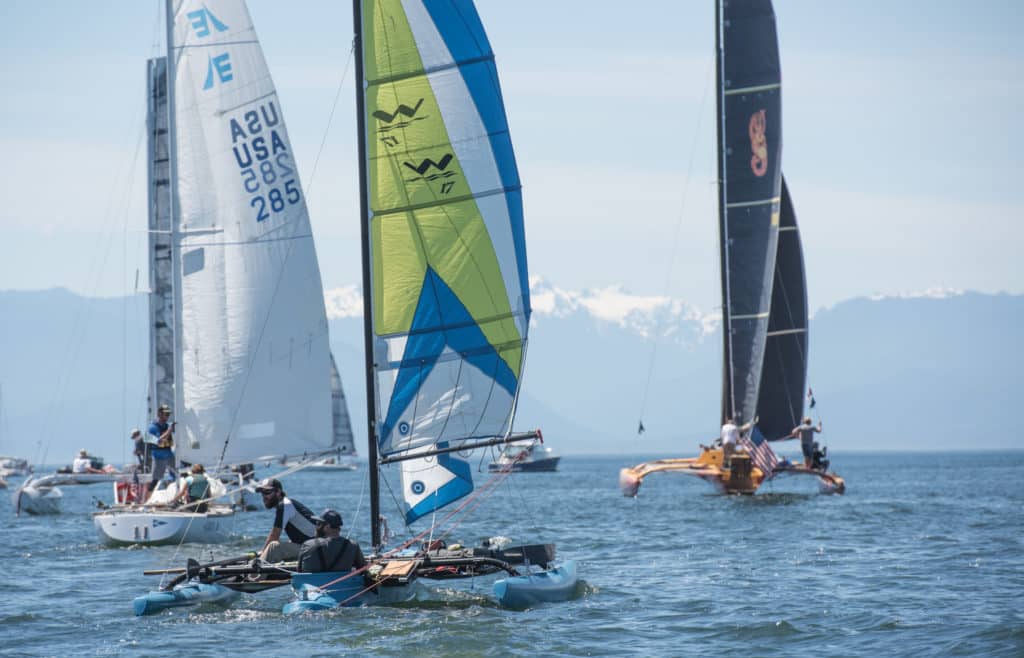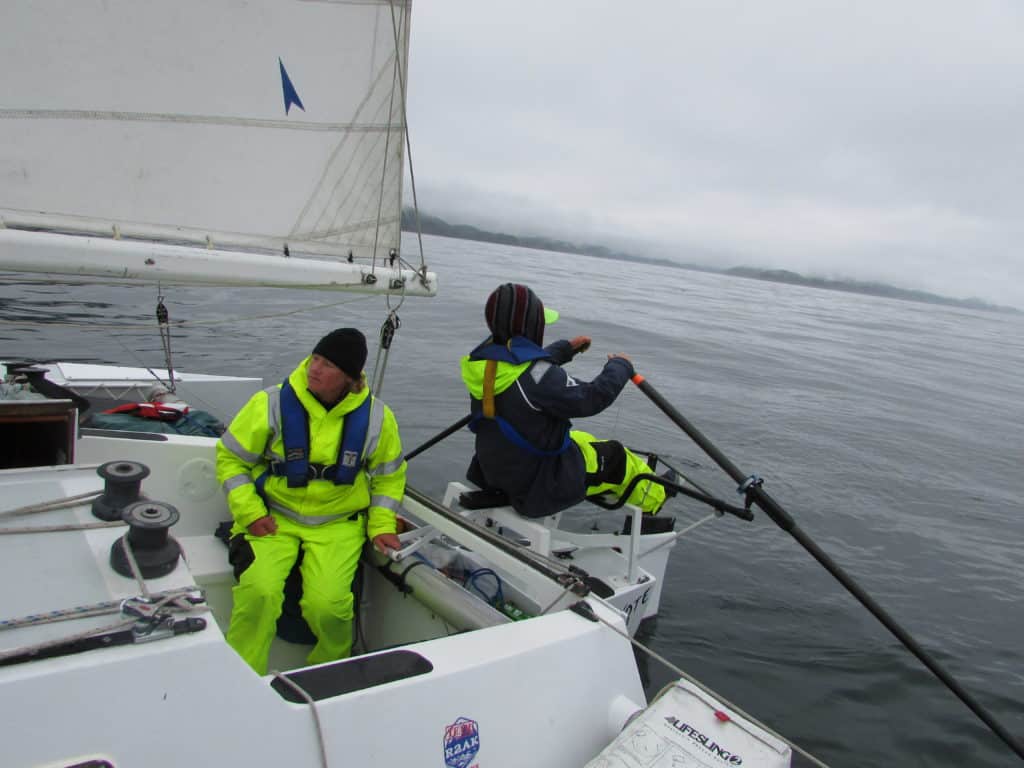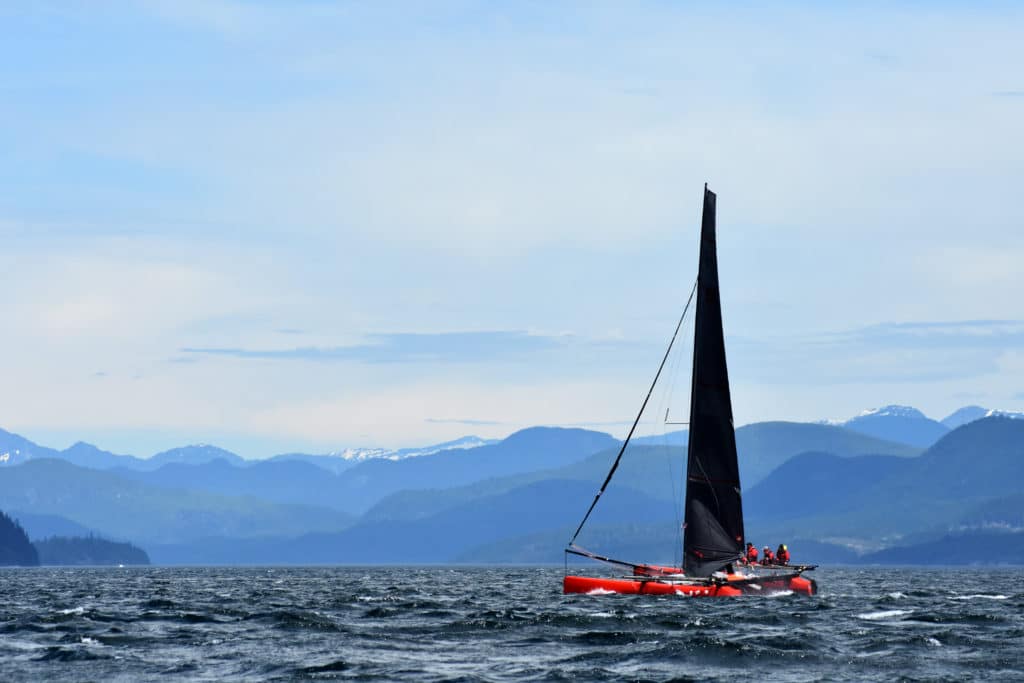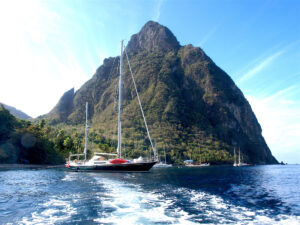
Green mountains tucked us into the quilted mattress of gray water spreading to the stone-lined shore. Seals popped their heads through the glassy surface that mirrored tall trees, wispy clouds and a boat of three women rowing toward a nook in the green. We were simply looking for a shallow spot to anchor to wait for the tide to turn so we could continue on into Johnstone Strait on the east side of Vancouver Island, British Columbia. Instead, we found ourselves tied up to an empty dock in an idyllic cove with an army of playful seals entertaining us into the evening.
Before I could help myself, I turned to my crewmate Katy and said, “Wouldn’t it be great to stay a bit longer?” She sighed. I winced, ready for her reply. “Jenny, this is a race. It’s called Race to Alaska, not cruise.” Now it was my turn to sigh. We had to pass by all these cute little towns, secluded anchorages and humpback-filled bays. Or, on this particular evening, we dipped in for a few hours of rest before pushing on into a foggy and windless morning as we tried to keep ahead of the other teams. Why was I doing this to myself? I’m a cruiser, darn it. I mean, I enjoy sailing for sailing’s sake, but I equally love the exploration of new waterways and the journey that begins when the sails come down.
And yet, this racing thing … it was starting to infect me, kind of like the cruising bug. As much as I wanted to poke around the anchorage, I felt the race beckoning me back on track. I wanted to be out among my new community of competitors clawing our way to Alaska.
We were participating in the second annual Race to Alaska, affectionately known as R2AK, a 750-mile race from Port Townsend, Washington, to Ketchikan, Alaska. R2AK rules stipulate that no motors or preplanned support are allowed, but stopping to buy things along the way is fair game. That’s basically it for guidelines. Competitors could sail, paddle, row, drift or do whatever they needed to do to get to the finish on whatever kind of craft they wished (entrants included everything from paddleboards to fancy racing trimarans). According to the R2AK website: “It’s in the spirit of tradition, exploration and the lawless self-reliance of the gold rush that Race to Alaska was born. R2AK is the first of its kind and North America’s longest human- and wind-powered race, and currently offers the largest cash prize for a race of this type.” The first-place prize is $10,000 in cash; the second-place finisher receives a set of steak knives.
Games of train dominoes excluded, I was finding several similarities to cruising that were stoking my fire. We racers were deemed crazy by land-loving folks — just like cruisers. The 750-mile race without engines was reminiscent of much of the cruising I’d done on my own sailboat, cursed with a faulty transmission and lacking reliable communication devices. And the 5200-strength bonds I was forming with racing sailors were setting up just as quickly, and I knew would last as long as those I still had with cruisers I’d met long ago.
That bond was how I ended up in the Race to Alaska.

I met Katy Stewart 14 years ago on another 750-mile jaunt. That time it was southbound toward sunny beaches instead of northbound to snow-capped peaks. We were part of the “kids” crowd doing the Baja Ha-Ha rally down the coast of Baja California, Mexico. At the time, we were in our mid-20s, sailing classic-plastics with our partners. They were on a Golden Gate 29; we were on a Kendall 32. Our two boats were the smallest and slowest in the fleet, often arriving into ports a day or two after everyone else.
None of us had seen the Baja Ha-Ha as a race, but rather as a deadline to stop working on our tired boats, untie the dock lines, and get cruising. We’d seen too many potential cruisers languishing in marinas fixing up “one last thing.” We knew we could easily fall into that trap with all the work our boat needed, so we threw the solar panels and uninstalled SSB down below and ghosted from the dock. We also saw the rally as a great way to meet other cruisers. Little did I know then that we would forge friendships that would last the ebbs and floods of time and distance.
I hadn’t seen Katy in about six years when she messaged out of the blue, “Want to race to Alaska with me?”
“Hell, yes!” was my immediate reply, even though I had a new catering company to run, chickens to supervise, and a garden to tend. How could I not go sailing?
Katy, like some sailors, has settled down, had kids, and works a 9-to-5 job. I have had a less-conventional life working and cruising on sailboats up until recently, so my anchor is a little less set. It’s been a blessing (sailing!) and a curse (the inability to stabilize on land). There is a veil that is lifted when you live on a boat for an extended period of time, especially in your 20s. As an older cruiser in a Mexican anchorage once told Katy, “You know you’ve messed up your life, right?” He didn’t mean it in the way that many folks at home did when they warned that as a 20-something you would screw up your life trajectory when you quit climbing the corporate ladder and emptied out your savings to buy a leaky old boat — how would you save up for retirement without a 401k? Instead, the old sailor half-grinned with the wisdom of living off the grid with the wind and waves. He knew that we “kids” would never be able to fully accept the conventional way of life. He knew we would always be glancing toward the horizon, checking for another glorious sunset or adrenaline-inducing squall, for something to jangle our nerves and wake us up to the present moment. That we would remember hanging off the bowsprit for midnight sail changes while bioluminescent droplets of water shot up from rocketing dolphins. How the taste of salt would linger on our lips and make us thirsty for the sea, our liquid home. We were screwed because we had not just a taste, but a solid swallow of how simple and hard and beautiful life can be on the water.

So, when Katy asked me to go sailing, I didn’t know the details (like that we’d be sailing a small home-built trimaran that had been sitting on a trailer for five years), but of course I said yes. It had been ages since I’d been sailing on a boat on which I wasn’t employed, and I was ready for some freedom. Well, as much freedom as you can have on a loosely set 750-mile course and a two-week job-fringed timeline. I couldn’t wait to be out there.
Our crew was comprised of Katy, her sister Emily Silgard, and myself. Our ride was Coyote, a 24-foot trimaran built by Katy and Emily’s dad, Larry Silva. The race was like speed-cruising. Except most of the time we were not speeding. In fact, due to a high-pressure system, we spent many more hours rowing through glassy stillness than I would have ever thought possible. We were on a foiling trimaran that weighed in at only half a ton. We should’ve been flying, right? Maybe it was the 20 gallons of water, three weeks’ worth of provisions, and obscene amount of wool socks and long underwear slowing us down. More often than I’d like to admit, we were happy to move forward at 1 knot — 1 knot! Sometimes we cheered that we weren’t losing ground in 4 knots of current as we frantically rowed from a stern-mounted sculling station we’d welded on for the race.
Luckily we were surrounded by astounding beauty the entire way, even when going in circles. Snowcapped Mount Baker watched over us for two days as we slalomed the San Juan and Gulf Islands and tacked up the Strait of Georgia. I kept an eye out for possible anchorages on the charts, but the timing was always off. If we’d been cruising, the long slow tacks into headwinds and current would have sent us gunk-holing into the Gulf Islands for the night. Instead, we beat into the northwest wind for days, and during the brief-but-dark nights, tried to stay out of the way of lit-up cruise ships, towering ferries, and powerful tugs pulling massive log piles on cables. Cruising sensibilities set in: Our priority was to stay safe, stay visible, and steer clear even if it meant losing time.
And then we got antsy.
We rowed through the notoriously treacherous Seymour Narrows with 11 knots of current roiling the waters all around. The massive whirlpool licking our stern was plenty of incentive to row like hell through the tidal bottleneck. A sensible cruiser would have waited for full slack, but the racing bug got the best of us, and we shot it during the ebb tide. Our bravery (or stupidity) was nonetheless rewarded with that dreamy seal-occupied anchorage. It was as if passing through the Narrows was the gateway to another world: dramatic wooded mountains with little sign of civilization, misty inlets leading into the wilderness, and hours without seeing another boat but visited often by seals, porpoises, humpbacks, orcas and eagles.
Near the north end of Vancouver Island, British Columbia, the battery we were using to power our electronics died. Navigation lights, emergency transponders and VHF radio were all critical to the safety of our operation, and with no sun in the forecast to power up our solar panel, we were forced to row into Port McNeil. We tied up among the fishing and cruising boats and were met with a community spirit that deep-charged our exhausted souls. The local marine store opened up after-hours so we could get a new battery. The dockmaster offered free showers and the encouragement, “You girls don’t ever give up!” Fellow mariners updated us about race and weather conditions, gave us advice about crossing Cape Caution, and donated a battery charger, food and medical supplies to our cause. Just like in my cruising days when I would dinghy over to a stranger’s boat to ask to borrow a wrench or offer an invitation to dinner, these sailors were instant community. Luckily, due to the relaxed rules of the R2AK, all of this assistance was inside the boundaries of acceptable racing because none of it had been planned.
Our final injection of community spirit came after a total of almost 13 days fighting currents, sloshing over ocean waves, and rowing through glassy open water. Humpbacks splashed off the bow as we ghosted into the entrance channel approaching Ketchikan. After spinning a full revolution in some nasty tidal eddies near the harbor breakwater, we landed at the dock to the applause of a healthy — albeit tired — crowd at 0200. We were stunned as they handed us beers, congratulated us on finishing, and asked us about our favorite moments out there.
Out there! Those watery ways! This sailing lifestyle!
We are screwed. Thank goodness we have 5200-strong bonds of friendship, community, and cruiser/racer craziness to hold us all together.
Jenny Goff is a sailor, writer and chef who learned how to cook diagonally on various cruising boats and yachts over the past 18 years. She is currently based on Whidbey Island, Washington.








